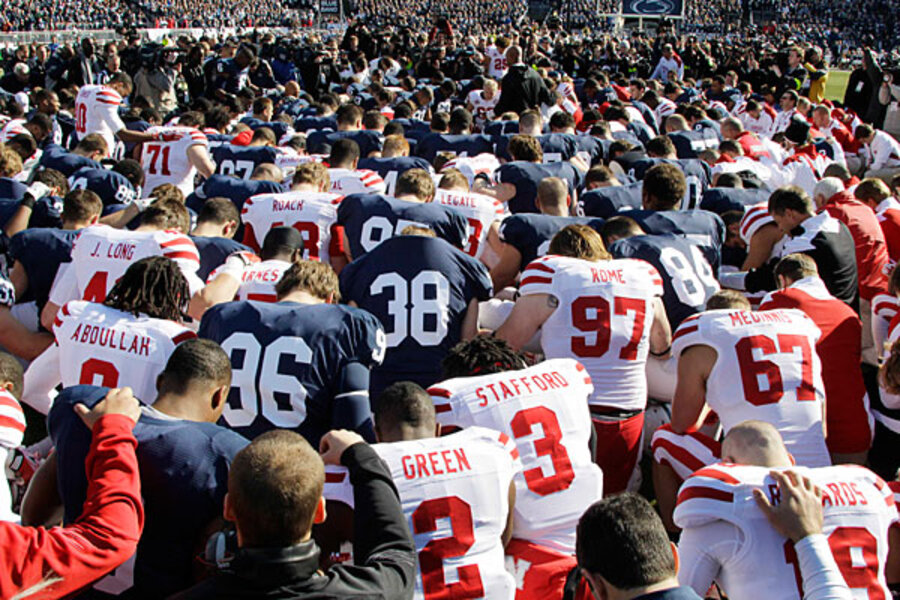Financial fallout for Penn State: $2 billion fundraising drive in danger?
Loading...
The child sex abuse scandal at Penn State University is driving the school into crisis mode: The new president is issuing statements assuring transparency, and the board of trustees just hired the international public relations firm Ketchum, best known for touting consumer brands, to figure out what steps to take next.
Amid the moves, the question of how the scandal will affect the university’s economic security over the long term is now coming into focus.
Penn State’s athletic program is certainly expected to take a hit. This week, Forbes estimated that the football program, valued at $99 million, will lose $10 million in sponsorships and donations. Moreover, the university’s endowment – often seen as a measure of a school’s brand value – may also be at risk, especially since the scandal is taking place in the middle of a $2 billion fundraising campaign that ends in two years.
Until today, Penn State has not found it difficult to raise money. In September, the university announced its endowment increased by $392 million this year and is currently valued at $1.83 billion. In fact, the university recently broke donation records. They totaled $136 million for fiscal year 2011 – more than the previous two years combined.
But the scandal could slow the flow of money. The university's seven-year capital campaign, designed primarily to fund undergraduate and graduate student scholarships, has hit 72 percent of its $2 billion target, the university reports. Banking the remaining 28 percent may present a significant challenge.
“Right now they probably won’t be asking for money,” says Stacy Palmer, editor of the Chronicle of Philanthropy. “That’s really a tough position to be in when you’re still that far away from your goal and you still have a lot of fundraising to do.”
A representative from Penn State’s office of development did not respond by press time to e-mails and a phone call seeking comment.
Dealing with a crisis while in the midst of a major fundraising effort is not unprecedented. In 2009, as Binghamton University in Vestal, N.Y., embarked on a $95 million campaign, a crisis broke that involved the school administration lowering admissions standards to benefit its Division I basketball team. In the aftermath, the school’s coach and athletic director resigned, and the university fired two assistant coaches, let go several players, and declined postseason play.
Binghamton officials faced the decision about whether or not to continue pushing for donations, but incoming president Peter Magrath says he moved forward. The result: The university exceeded its goal by $5 million in six months. Mr. Magrath says the key was “honesty, being transparent, and answering all the questions.”
“In my view, being open and putting everything out there, not hiding stuff, built trust and credibility. I think it’s absolutely essential in these types of situations,” he says. While he admits that the Penn State situation is unprecedented, he expects the university’s new leadership will slow down, but not necessarily hold back fundraising.
“At some point in the near future they’re going to decide to keep moving ahead because they have a story to tell. They’re certainly not going to hunker down and not continue fundraising,” he says.
When a university is hit with a crisis moment, it may shift from donation outreach to grooming its biggest donors in order to keep channels open once the storm passes.
“What’s important to remember is that people who are positioned to make major gifts have long-term relationships with the institution and want the institution to be successful. If they feel the institution is taking ownership and is showing leadership, they will typically come back,” says Rae Goldsmith, vice president of advancement resources at the Council for Advancement and Support of Education (CASE), a professional association assisting in alumni relations and development.
According to CASE data, the biggest donation Penn State received this year was $88 million from Terrence and Kim Pegula to build a sports arena and establish a NCAA Division I ice hockey program. Mr. Pegula, a former oil and gas industry executive, is a 1973 graduate of the university.
The second biggest gift this year was $25 million from William Schreyer, a former chairman of Merrill Lynch & Company, and a 1948 graduate.
Some Penn State donors may actually increase their giving following the scandal to rally their support, says Ms. Palmer of the Chronicle of Philanthropy. For example, Baylor University’s endowment increased 30 percent between 2005 and 2006 following a scandal involving the 2003 murder of a basketball player by a teammate.
Alternatively, alumni may choose to “donate to parts of the institution outside athletics to symbolize the school’s importance and that it does important work to educate students in many ways,” Palmer says.
Andrea Johnson, who earned her master’s degree in sociology from Penn State in 1996 and who says the university “made many significant contributions” to her career, says she will continue her giving despite the scandal because she did not associate her experience there with athletics. However, had the scandal involved someone in the sociology department, she says, “it would probably impact my giving.”
While major donor giving may steady its course over the long-term, admissions – another important source of revenue – to Penn State are expected to flounder, at least for next fall.
Parents are particularly concerned with how an association with the university could affect the future job prospects of their children, says Craig Meister, president of Tactical College Consulting in Stevenson, Md.
“College is increasingly being viewed as a professional investment,” he says. “And parents and students want to invest in a school whose reputation they believe will pay large dividends in the future. Penn State no longer looks like a safe bet.”





